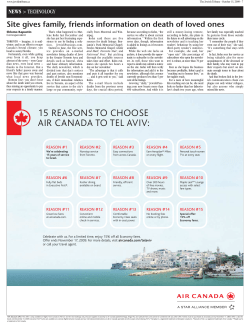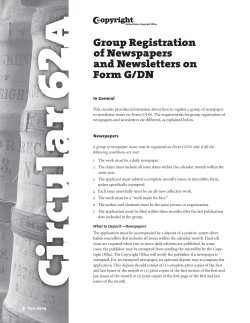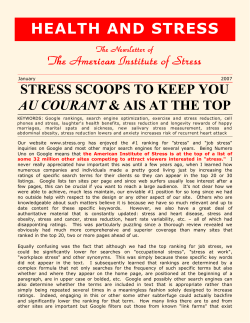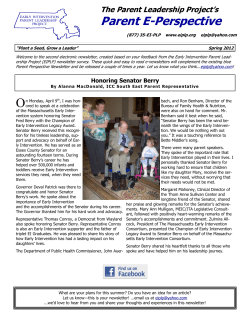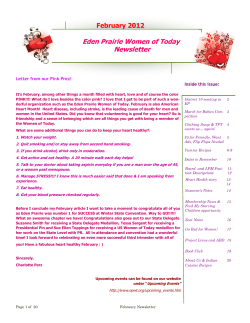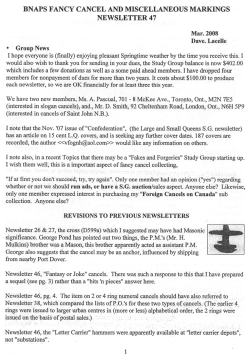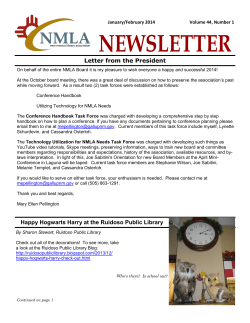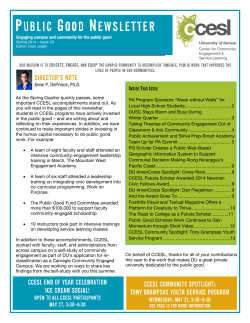
The Bigger Picture “Genealogy is like a Kitchen Spice Rack”
Instructor: Christa Klemme How much do you know? The Bigger Picture “Genealogy is like a Kitchen Spice Rack” “Genealogy is like a kitchen spice rack. You may have 10 to 15 different spices in your cupboard, but there are only a few that you use in almost every recipe: salt, pepper, and maybe garlic powder. Every now and then, a recipe calls for other spices – rosemary, curry, thyme, sage – that have been in your cabinet for heaven only knows how long, but they’re there when you need them. Similarly, in genealogy, you may rely on those few records that researchers use all the time in their ancestral quests: censuses, vital records, wills and deeds. But in order to break through the brick walls in your family research, you’ll need to look at the lesser-used records in your genealogical spice rack.” “Key Ingredients” by Sharon DeBartolo Carmack, Family Tree Magazine Individual Timelines As you begin to collect more information that just the name of your ancestor, their birth, marriage, and death dates, it would be a good idea to create an individual timeline. You could create your timeline with your own style which best helps you evaluate and continue your search for more records of this ancestor. This timeline at a minimum would include the dates of events in chronological order and the event and its location. By including all available events to this ancestor, you would be able to uncover inaccurate or missing time periods of information. In your research, be mindful of citing your sources accurately (in case of a need to find the source data again or to prove the source data). here. Continue ewsletter text here. Continue newsletter text here. Continue newsletter text here. Continue newsletter text here. Continue n ewsletter text here. Continue newsletter text here. Continue newsletter text here. Continue newsletter text here. Continue newsletter text President Brigham “We havenewsletter a worktext to here. do just as important itsContinue here. Continue newsletter text here. Continue Young newslettersaid: text here. Continue Continue newsletter textin here. sphere the Savior’s was in its text sphere. Our fathers newsletter text here. Continueas newsletter text here.work Continue newsletter here. Continue newslettercannot text here.be made perfect without us; we cannot be made perfect without them. They have done their work and now sleep. We are now called upon to do ours; which is to be the greatest work man ever performed on the earth” (Discourses of Brigham Young, sel. John A. Widtsoe, Salt Lake City: Deseret Book Co., 1941, p. 406). Immigration Records Immigrant arrival records were kept generally from 1820 onward due to the U.S. Steerage Act. Port city for immigration records FHL microfilm catalogue for port of arrival city and “immigration” NARA microfilm catalogue for port of arrival city and “immigration” Ancestry.com or genealogy.com City Directories Provide addresses, people within same residence, occupations, can also give indication of time range of migration or immigration to the city, give names of local fraternities Local, state, FHL, or university libraries Local genealogical society Ellisisland.org Ellis Island immigrants Istg.org Immigrant Ships Transcribers Guild Your local and state libraries for various holdings of transcribed immigration records Szucs, Loretto Dennis. “They Became Americans: Finding Naturalization Records & Ethnic Origins” Salt Lake City, UT: Ancestry, 1998 Continue newsletter text here. Continue newsletter text here. Immigration Records Provide: Immigration Indexes provide a shortcut to family’s port and date of arrival Passenger lists from 1820 to 1891 were called “Customs Lists” The U.S. gave the forms to the Continue newsletter text here. Continue newsletter text here. shipping company to complete at the port of Continue newsletter text here. Continue newsletter text here. departure. These lists contained name of ship, its Continue newsletter records text here.may Continue newsletter textand here.port Naturalization provide the date master, port of departure, port of arrival, Continue newsletter text name, here. Continue newsletter text here. of arrival, the ships the port of departure, the passengers name, their age, sex, occupation, Continue newsletter ancestor’s birth text datehere. andContinue place. newsletter text here. and nationality. Continue newsletterrecords text here. Naturalization prior to 1906 are available Immigration Passenger Lists from 1891 to 1954: Naturalization Records through the FHL or municipal courthouses where your In 1893, Passenger lists had 21 columns of immigrant ancestor arrived or settled. Post 1906 the information requested. records are available through the US Citizenship and By 1917, Passenger lists had 38 columns of Immigration Services at http://www.uscis.gov (approx. information requested. $35.) The NARA has filmed most original passenger lists from 1820 to 1957. Source of Immigration and Naturalization: “The Secret Garden” by Sharon DeBartolo Carmack and “Routes of Passage” by Sharon DeBarotolo Carmack Family Tree Magazine Fraternal Societies Fraternal societies were very popular social organizations in the late 19th and early 20th centuries Potential signs of your ancestor’s In 1896, one is eight U.S. adults were affiliation with a fraternal organization: members of a fraternal order (4.7 million members). o Open acknowledgment Fraternal societies provided friendship, o Pictures in organizational dress regalia opportunities to be among people of similar o Stationary with insignia faiths, occupations, ethnic groups, political o Jewelry with insignia affiliations, and usually had within the society o Headstone with insignia a strong sense of community and service. Examples of Fraternal Societies: Social Societieso Free Masons o Odd Fellows o Order of the Eastern Star For Further Research Try: The International Encyclopedia of Secret Societies & Fraternal Orders by Alan Axelrod Service Societieso Independent Order of Odd Fellows (often joined by immigrants for social service o Lions Club o Rotary Club Trade Societies (some resembled unions)o The Grange (aka The Patrons of Husbandry) o Brotherhood of Locomotive Engineers (now a part of International Brotherhood of Teamsters) Religious o Knights of Columbus (Catholic ancestors) Political You may be able to obtain your ancestors application to join the fraternity, membership records, participation in the organization, or the organization’s published history. First, check the Family History Library, local and state archives. Try writing to the local organization prior to writing the larger organization record repository. (If not located in these places, the local fraternal organization would likely know where the records are held.) When writing for information, include your ancestor’s name, Continue newsletter text here. Continue newsletter text here. Continue newsletter text here. Continue Source of information newsletter text here. Continue newsletter text here. Continue newsletter text here. Continue newsletter text “Secret Signs” by Rhonda McClure here. Continue newsletter text here. Continue Family Tree Magazine.com newsletter text here. Continue newsletter text here. call-out box. Consider including customer Continuetext newsletter text here. Continue newsletter text city and county of residence and years of residence. Please remember these records are private, and they are not required to share them with the public. Church Records Source: “Faith’s Rewards” by David A. Fryxell Family Tree Magazine Church RecordsAside from births, christenings, marriages, and deaths, churches kept records including: member lists, household lists, tithing records, and migration and immigration details. They may also contain significant events like confirmations, bar mitzvahs and first communions. Keep in mind that churches also ran Some Tips on Religious background of immigrant groups (aside from those seeking religious asylum): German families were likely Lutheran or Catholic Scandinavians were likely Lutheran Germans and Scandinavians moved to the Midwest Church of England parishioners were likely Episcopalians The Scottish Church parishioners likely became Presbyterians Jews moved from Eastern Europe to larger cities Some groups created their own churches Greek and schools, orphanages, cemeteries. Some even published congregational histories and newspapers. Russian Orthodox churches, Swedish Baptist churches, African Methodist Episcopal churches created by freed slaves, and new churches were established (i.e. The Church of Jesus Christ of Latter-day Saints). Tips for Researching Church Records: o Find the location where your ancestor lived- remember they may have gone to the closest church rather than their denomination due to the closeness of the church to their home or the lack of a church of their beliefs. o Study the religion (and the time period specifically) within that area. Did the ethnicity, local history, and location play a role into your ancestor’s faith? o Contact the local, regional, or national church for its location of church records/archive. o Search the FHL, local library, state library, and historical societies for church records o Be open to your ancestor changing faiths due to marriage, religious reformation, or other reasons. o Find out their religious denomination through clues in their photos (i.e. christenings, first communion, confirmation, altar boys pictures, or props within the pictures, etc) o Old maps and city directories can help you find the local churches o Find clues in birth, marriage, and death certificates, baptismal certificates, church school records, funeral card, obituaries and death notices in local newspapers o Try the Periodical Source index for published church records o See what’s available online at www.ancestry.com or www.usgenweb.org for transcribed records o See Cyndi’s List for a wide variety of information on “Religion & Churches” http://www.cyndislist.com/religion.htm Military Records Civil War The information that is available at the NARA Draft records for the Civil War (both white depends on the specific war. citizens and non citizens) are available only Indexes to the Revolutionary War service records at the NARA in Washington D.C. under the and actual records are available at the FHL and “National Archives Record Group 110”. NARA. Records include the man’s name, The US Gave Bounty Land Warrants to veterans residence, age as of 1 July 1896, instead of payment. These records can be found occupation, marital status, birth location, online at Heritage Quest. and possibly the military organization. (These records have not been microfilmed.) World War IThree Draft Registrations took place, between The Civil War Soldiers and Sailors System 1917 and 1918, registering over 24 million men was created by the National Park Service between the ages of 18 and 45. Registration from records held by the NARA. It is a cards included the registrants name, age, date database of over 6.3 million names of Civil and place of birth, home address, race, War Soldiers and Sailors. citizenship, occupation, personal description, and http://www.itd.nps.gov/cwss/ “Other prior military service. With this information, you information includes: histories of regiments could then look for more World War I records. in both the Union and Confederate Armies, The original WWI Draft Registration records are links to descriptions of 384 significant located at the NARA in Georgia. They are also battles of the war, and other historical available at the FHL, and online at information. Additional information about www.ancestry.com . You may also have luck at soldiers, sailors, regiments, and battles, as the free site: well as prisoner-of-war records and http://userdb.rootsweb.ancestry.com/ww1/draft/s cemetery records, will be added over time.” earch.cgi Try searching the FHL for records you may want from the NARA. The FHL may have the Try individual state archives for possible military records. For microfilm you need. example, The State of Missouri has a free online database of The National Archives does not hold state military records of Missourians who served during the period militia records: For these records, you will need of the War of 1812 to Word War I to contact the appropriate State Archives. http://www.sos.mo.gov/archives/soldiers/ Military Records pt 2 Types of Military Service Records (sourced directly from www.archives.gov) This is a list of the Older Military Service Records held at Washington, DC. Branch of Dates Service Volunteers Military service performed by persons serving during an emergency and whose service was considered to be in the Federal interest, 1775 - 1902 Regular Army Enlisted personnel, 1789 - October 31, 1912 Officers, 1789 - June 30, 1917 Navy Enlisted personnel, 1798 - 1885 Officers, 1798 - 1902 Marine Corps Enlisted personnel, 1798 - 1904 Some officers, 1798 - 1895 Coast Guard Persons who served in predecessor agencies to the U.S. Coast Guard: the Revenue Cutter Service (Revenue Marine), the Life-Saving Service, and the Lighthouse Service, 1791 - 1919 Confederate States Persons who rendered military service for the Confederate States government in its armed forces, 1861 - 1865 Veterans Records Claims files for pensions based on Federal military service, 1775 - 1916 and Bounty land warrant application files relating to claims based on wartime service, 1775 - 1855 “How to Order Older Military Service or Pension Records Order compiled records based on pre-1917 military service in the United States forces. Form Number: NATF 86 Military Pension/Bounty Land Warrant Applications Order copies of military pension application files based on Federal (not State or Confederate) service between 1775 and 1903 (before World War I). Categories of pension/bounty land files available using NATF Form 85: 1. A complete Civil War and later pension application file (up to 100 pages), based on Federal (not State or Confederate) military service during the Civil War or later (includes the Pension Documents Packet.) 2. A complete Federal pre-Civil War military pension application based on Federal military service before 1861 (includes the Pension Documents Packet.) 3. A pension document packet that contains reproductions of eight documents containing genealogical information about the pension applicant, to the extent these documents are present in the file. 4. A complete military bounty land application file based on service 1775-1855 (includes only rejected Revolutionary War applications). “ www.archives.gov State Militia Records Access to Military Records by the General Public, including genealogists who are not next-of-kin Post 1917http://www.archives.gov/st-louis/military-personnel/public/index.html Occupational Records Occupational records may include dates and places of previous employment, education, marital status, and other misc. data. o Apprenticeship and indenture servant (in Colonial America) records would include the names of your ancestor’s parents. These records were likely found at the local level or historical societies, and if no luck try the state archives. o Look in city directories for possible indication of occupation. Find city directories microfilmed at the FHL, local and state libraries, and some are online at ancestry.com. Also find town and county histories that have people’s occupation lists in them. Try Heritage Quest too. o Read up on local history for an indication of occupations in the area (mining, farming, railroad, factory work, etc). o Check out family photos for possible clues o Obituaries may give clues on occupations. o If you ancestor was a farmer, they may have land records to locate. o If your ancestor lived in a company town, like many miners did, then you can look into researching “Company Towns” and the occupation and location at your local library. o For pensions of employees try the local government level for records of employees like firefighters and police officers. Links for researching public employeeshttp://www.cyndislist.com/publicservants.htm o Keep in mind that governments required licensing for some private occupations. These records may be available (i.e. saloon keepers, street venders, etc) These records may include name, age, birth date, residence, marital status, and education.) Check state repositories for these records. o Licenses for doctors, dentists, nurses, pharmacists, lawyers, etc were issued and likely held at the state archives. Our 19th Century immigrant ancestors were likely a contribution to building up of America in the area of transportation. It is likely that you have ancestors who worked building or running the railroads. To find records of employment, check the railroad company’s archives, historical and railroad societies, museums, archives, and private collections. The government also kept track of some 20th Century railroad employees. If you ancestor’s Social Security number (on a death certificate or the SSDI) begins with 700 and 728/729, then that indicates that he/she received retirement benefits from the US Railroad Retirement Board (http://www.rrb.gov/mep/genealogy.asp ). The RRB pension records would contain copies of the personas death certificates. According to their site, “Our records are limited to individuals who worked in the rail industry after 1936.” Record requests are $27. “…the RRB's records are only on persons whose employers were covered under the Railroad Retirement Act. Employers such as streetcar, interurban, or suburban electric railways are not covered under this Act.” Prior to 1850 I struggle to find records, where do I look? Prior to1790, colonial states were irregular at taking census, however there are many that did. Colonial enumerations are available at: USGenWeb : http://www.us-census.org FamilyHistory Library microfilm Heritage Quest at FHC or library Since the 1850 Federal Census is the earliest record in which household members are listed by name, it is often more difficult to find records of similar detail on ancestors. Other sources you may try that would be helpful would be: published family or local histories, cemetery and church records, online message boards, or original records (such as court, land, and tax records). Google it! The Allen County Public Library ( ACPL) created and maintains Always check for published The Periodical Source Index (PERSI) If you find an article in a family histories (online, the FHL, journal that you are seeking, you can always request it from the ACPL through their interlibrary loan (online at http://www.genealogycenter.org ) or at other libraries). Check pedigree sources for more information (familysearch.org, ancestry.com, DAR) www.NewEnglandAncestors.org has moved to: www.AmericanAncestors.org Google search your ancestor (be more specific if you get a wide variety of results).
© Copyright 2025


